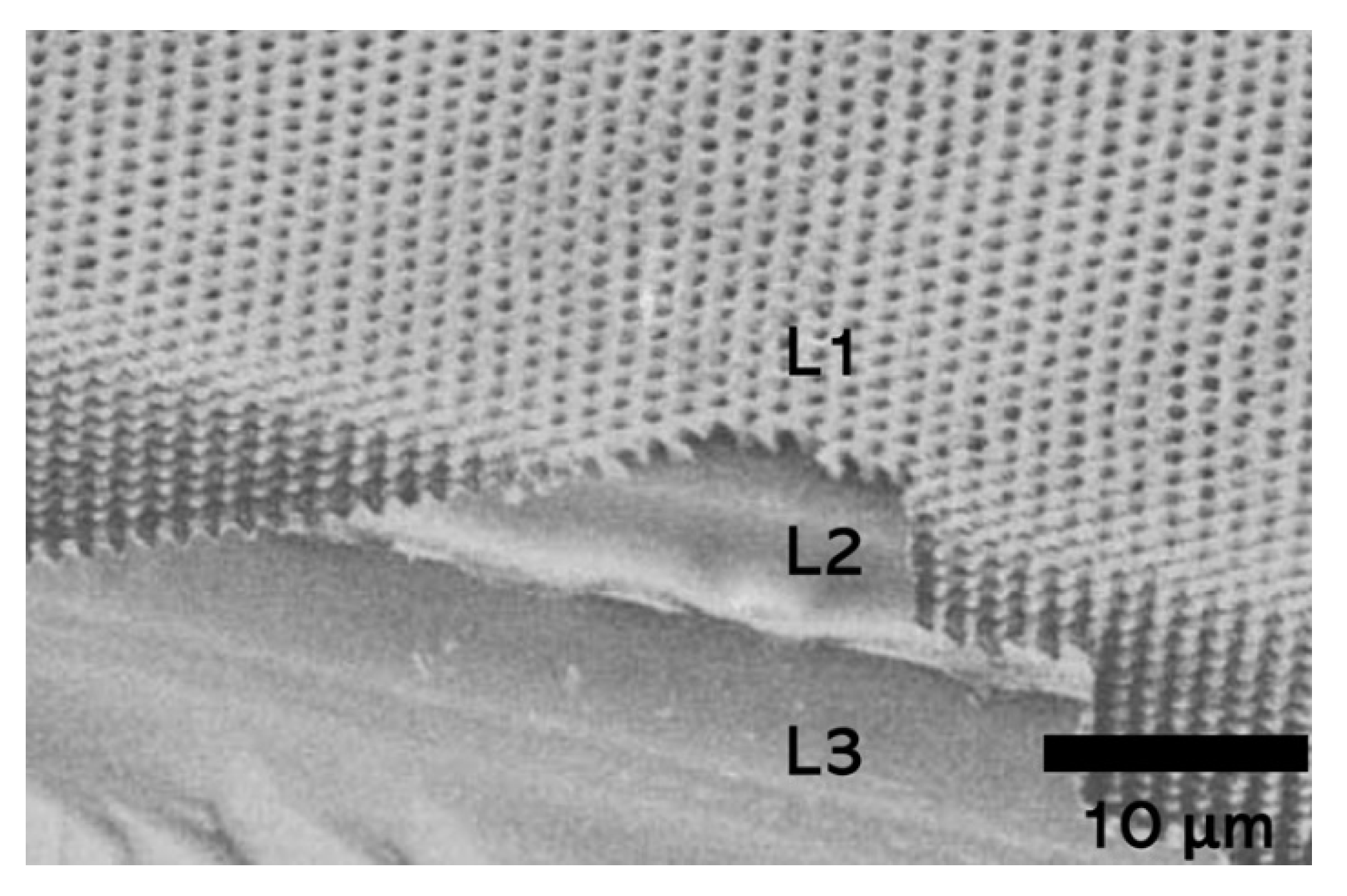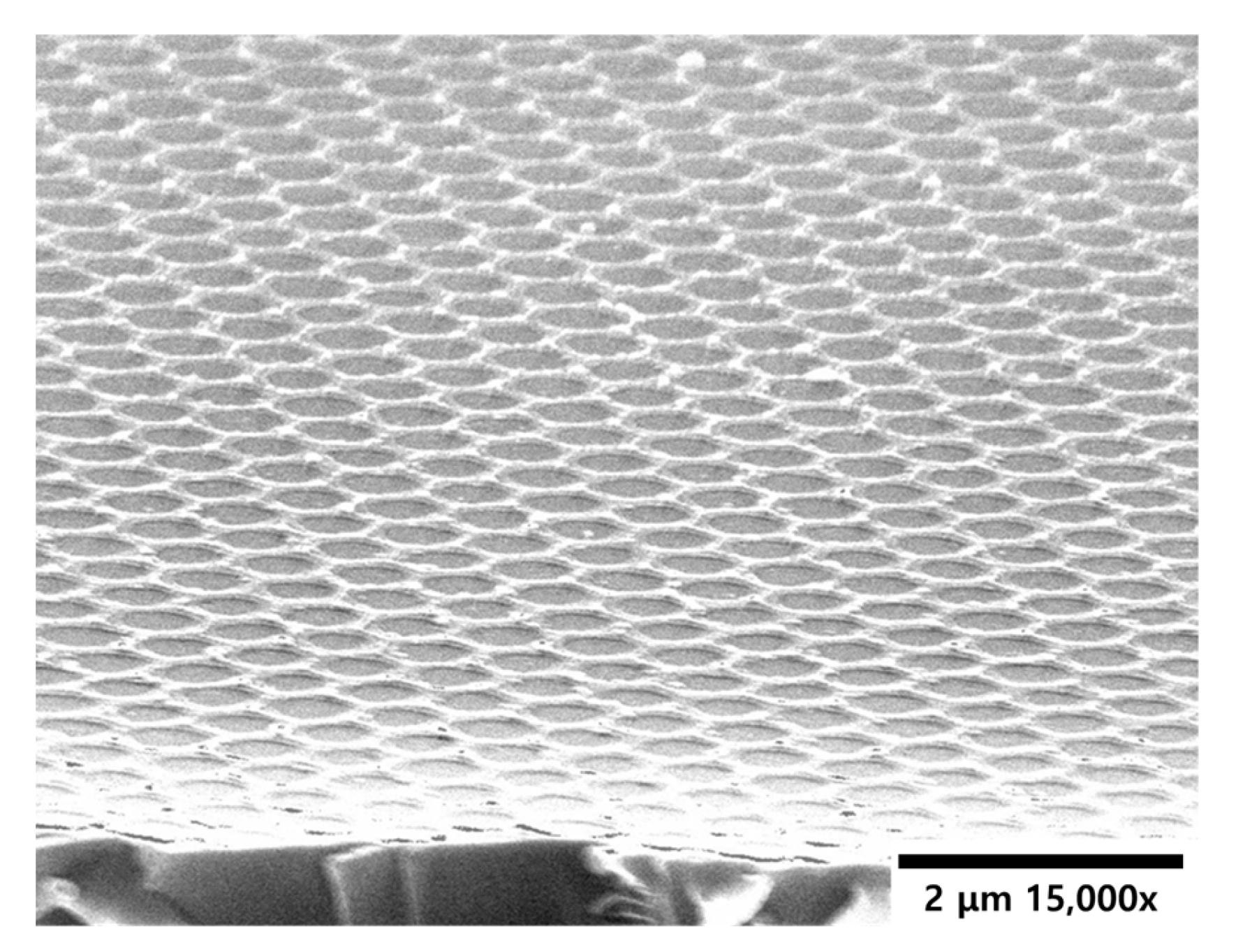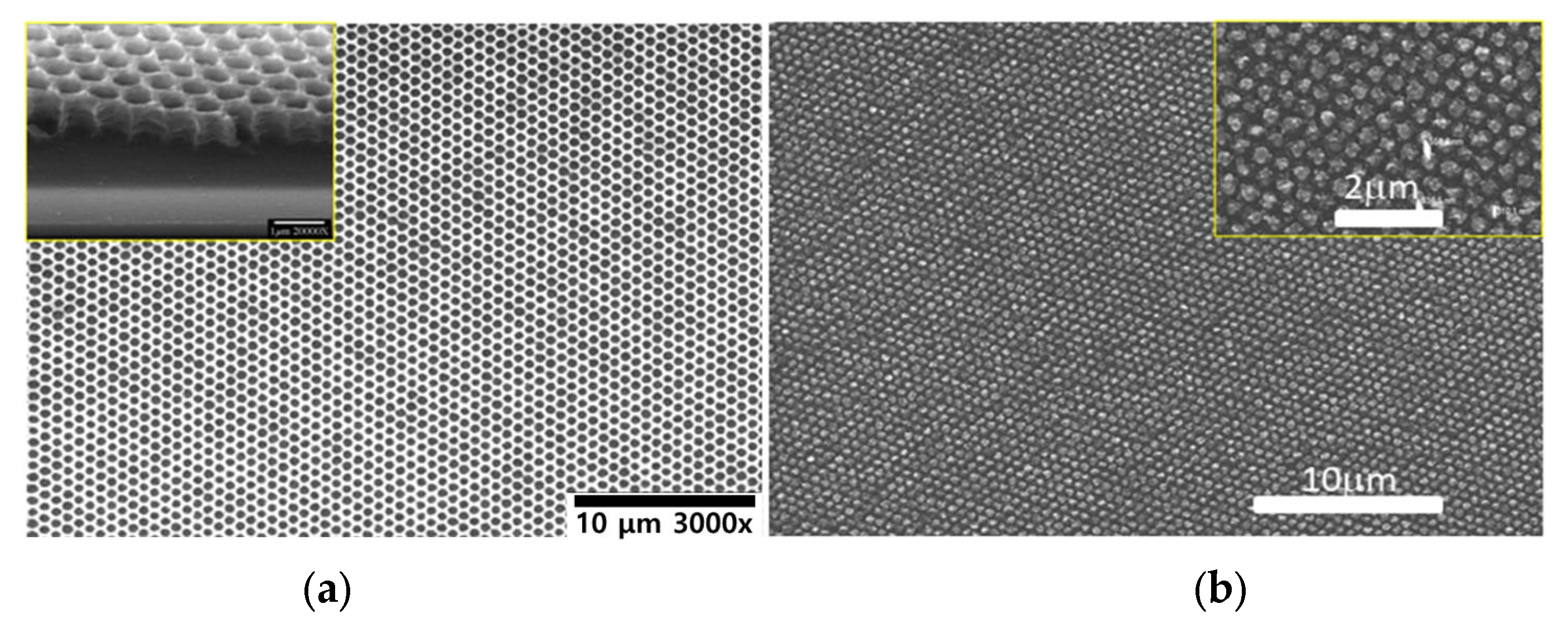Fabrication of Large Area, Ordered Nanoporous Structures on Various Substrates for Potential Electro-Optic Applications
Abstract
:1. Introduction
2. Materials and Methods
3. Results and Discussion
4. Conclusions
Author Contributions
Funding
Institutional Review Board Statement
Informed Consent Statement
Data Availability Statement
Conflicts of Interest
References
- Deyang, J.; Tao, L.; Harald, F. Patterning and applications of nanoporous structures in organic electronics. Nano Today 2020, 31, 100843. [Google Scholar]
- Huang, Y.G.; Shiota, Y.; Wu, M.Y.; Su, S.Q.; Yao, Z.S.; Kang, S.; Kanegawa, S.; Li, G.-L.; Wu, S.-Q.; Kamachi, T.; et al. Superior thermoelasticity and shape-memory nanopores in a porous supramolecular organic framework. Nat. Commun. 2016, 7, 11564. [Google Scholar] [CrossRef] [PubMed] [Green Version]
- Mohsin, A.B.; Jun, K.; Hoyoung, J.; Seok-Min, K. Fabrication of Highly Packed Plasmonic Nanolens Array Using Polymer Nanoimprinted Nanodots for an Enhanced Fluorescence Substrate. Polymers 2018, 10, 649. [Google Scholar]
- Li, X.; Shao, J.; Tian, H.; Li, X.; Chen, X.; Zhu, X. High-transmittance and focal controllable plano-convex lenses with embedded nanolens bottoms formed by electrowetting on a colloidal monolayer. J. Mater. Chem. C 2020, 8, 2659–2663. [Google Scholar] [CrossRef]
- Junsoo, P.; Changhoon, C. Aluminum based reflective nanolens arrays to improve the effectiveness of ultraviolet inactivation of Escherichia coli O157:H7 and Listeria monocytogenes in water and a sucrose solution. Food Sci. Biotechnol. 2020, 29, 1281–1287. [Google Scholar]
- Sergey, A.S.; Alexey, Z.; Dmitri, V.P.; Stanislav, O.G.; Eugeny, V.P.; Alexey, P.P.; Svetlana, N.K.; Sergei, A.K.; John, B.B.R.; Sergey, I.K.; et al. Plasmonic Nanolenses Produced by Cylindrical Vector Beam Printing for Sensing Applications. Sci. Rep. 2019, 9, 19750. [Google Scholar]
- Cai, J.; Lv, C.; Hu, C.; Luo, J.; Liu, S.; Song, J.; Shi, Y.; Chen, C.; Zhang, Z.; Ogawa, S.; et al. Laser direct writing of heteroatom-doped porous carbon for high-performance micro-supercapacitors. Energy Storage Mater. 2020, 25, 404–415. [Google Scholar] [CrossRef]
- Rebecca, L.W.; Michael, J.B.; Beecher, H.W.; Elizabeth, R.K.; Mark, A.F.; Richard, J.M.; Gery, L.M. Direct writing of textured ceramics using anisotropic nozzles. J. Eur. Ceram. Soc. 2021, 41, 1945–1953. [Google Scholar]
- Sergey, G.; Vitaliy, A.G.; Joan, V.-C.; Christian, D. Direct e-beam writing of dense and high aspect ratio nanostructures in thick layers of PMMA for electroplating. Nanotechnology 2010, 21, 295303–295310. [Google Scholar]
- Birgitta, S.; Loic, A.; Laurent, B.; Abdelghani, O.; Madouri, A.; Gilles, P.; Juan, P.; Ralf, J.; Jacques, G. Direct FIB fabrication and integration of “single nanopore devices” for the manipulation of macromolecules. Microelectron. Eng. 2010, 87, 1300–1303. [Google Scholar]
- Zhang, W.; Tian, Q.; Chen, Z.; Zhao, C.; Chai, H.; Wu, Q.; Li, W.; Chen, X.; Deng, Y.; Song, Y. Arrayed nanopore silver thin films for surface-enhanced Raman scattering. RSC Adv. 2020, 10, 23908–23915. [Google Scholar] [CrossRef]
- Alexander, M.H.; Pravini, S.F.; Smilgies, D.M.; Jeffrey, M.M. Freeing Organic Semiconductor Nanowires from Nanoporous Aluminum Oxide Templates: Effects on Morphology, Crystal Structure, and Molecular Aggregation. Cryst. Growth Des. 2021, 21, 721–728. [Google Scholar]
- Yu, J.; Wang, F.; Wang, Y.; Gao, H.; Li, J.; Wu, K. Interfacial reaction growth approach to preparing patterned nanomaterials and beyond. Chem. Soc. Rev. 2010, 39, 1513–15325. [Google Scholar] [CrossRef]
- Shobha, S.; Kyoung-Tae, K.; Alexander, B.; Natalia, M.L.; Paras, N.P. Fabrication and Characterization of Gold−Polymer Nanocomposite Plasmonic Nanoarrays in a Porous Alumina Template. ACS Nano 2010, 4, 2249–2255. [Google Scholar]
- Hu, X.; Zhang, X.; Chen, X.; Luo, M. Solution route to large area all-TiO2 one-dimensional photonic crystals with high reflectivity and different structural colors. Nanotechnology 2020, 31, 135209. [Google Scholar] [CrossRef]
- Menaka, D.Z.; Masahiro, Y.; Bongshik, S.; Kenji, I.; Takuya, I.; Shumpei, K.; Koki, I.; Yoshinori, T.; Ranko, H.; John, G.; et al. Thermal management for CW operation of large-area double-lattice photonic-crystal lasers. J. Opt. Soc. Am. B 2020, 37, 3882–3887. [Google Scholar]
- Hyuk Moon, J.; Yang, S. Creating Three-Dimensional Polymeric Microstructures by Multi-Beam Interference Lithography. J. Macromol. Sci. C 2005, 45, 351–373. [Google Scholar] [CrossRef] [Green Version]
- Woo, L.; Ran, J.; Ulrich, G.; Kornelius, N. Fast fabrication of long-range ordered porous alumina membranes by hard anodization. Nat. Mater. 2006, 5, 741–747. [Google Scholar]
- Baquedano, E.; Torné, L.; Caño, P.; Postigo, P.A. Increased Efficiency of Solar Cells Protected by Hydrophobic and Hydrophilic Anti-Reflecting Nanostructured Glasses. Nanomaterials 2017, 7, 437. [Google Scholar] [CrossRef] [PubMed] [Green Version]
- Hongsub, J.; Min-Joon, P.; Kiseok, J.; Chaehwan, J.; Jaehyeong, L. Combining Interference Lithography and Two-Photon Lithography for Fabricating Large-Area Photonic Crystal Structures with Controlled Defects. Appl. Sci. 2021, 11, 6559. [Google Scholar]
- Marc, J.M. Lithography. In Fundamentals of Microfabrication, 2nd ed.; CRC Press: Boca Raton, FL, USA, 2002; pp. 2–10. [Google Scholar]
- Woo, L.; Ran, J.; Caroline, A.R.; Ulrich, G.; Kornelius, N. Wafer-scale Ni imprint stamps for porous alumina membranes based on interference lithography. Small 2006, 2, 978–982. [Google Scholar]








Publisher’s Note: MDPI stays neutral with regard to jurisdictional claims in published maps and institutional affiliations. |
© 2021 by the authors. Licensee MDPI, Basel, Switzerland. This article is an open access article distributed under the terms and conditions of the Creative Commons Attribution (CC BY) license (https://creativecommons.org/licenses/by/4.0/).
Share and Cite
Jee, H.; Jeon, K.; Park, M.-J.; Lee, J. Fabrication of Large Area, Ordered Nanoporous Structures on Various Substrates for Potential Electro-Optic Applications. Appl. Sci. 2021, 11, 12136. https://doi.org/10.3390/app112412136
Jee H, Jeon K, Park M-J, Lee J. Fabrication of Large Area, Ordered Nanoporous Structures on Various Substrates for Potential Electro-Optic Applications. Applied Sciences. 2021; 11(24):12136. https://doi.org/10.3390/app112412136
Chicago/Turabian StyleJee, Hongsub, Kiseok Jeon, Min-Joon Park, and Jaehyeong Lee. 2021. "Fabrication of Large Area, Ordered Nanoporous Structures on Various Substrates for Potential Electro-Optic Applications" Applied Sciences 11, no. 24: 12136. https://doi.org/10.3390/app112412136
APA StyleJee, H., Jeon, K., Park, M.-J., & Lee, J. (2021). Fabrication of Large Area, Ordered Nanoporous Structures on Various Substrates for Potential Electro-Optic Applications. Applied Sciences, 11(24), 12136. https://doi.org/10.3390/app112412136







